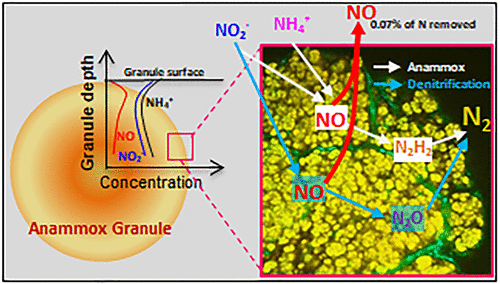当前位置:
X-MOL 学术
›
Environ. Sci. Technol.
›
论文详情
Our official English website, www.x-mol.net, welcomes your
feedback! (Note: you will need to create a separate account there.)
Experimental Evidence for in Situ Nitric Oxide Production in Anaerobic Ammonia-Oxidizing Bacterial Granules
Environmental Science & Technology ( IF 10.8 ) Pub Date : 2018-04-30 , DOI: 10.1021/acs.est.8b00876 Rathnayake M. L. D. Rathnayake 1, 2 , Mamoru Oshiki 2, 3 , Satoshi Ishii 2, 4, 5 , Takahiro Segawa 6, 7 , Hisashi Satoh 2 , Satoshi Okabe 2
Environmental Science & Technology ( IF 10.8 ) Pub Date : 2018-04-30 , DOI: 10.1021/acs.est.8b00876 Rathnayake M. L. D. Rathnayake 1, 2 , Mamoru Oshiki 2, 3 , Satoshi Ishii 2, 4, 5 , Takahiro Segawa 6, 7 , Hisashi Satoh 2 , Satoshi Okabe 2
Affiliation

|
Although nitric oxide (NO) emissions from anaerobic ammonium oxidation (anammox)-based processes were reported previously, the NO production pathways are poorly understood. Here, we investigated the NO production pathways in anammox granules in detail by combining 15N-stable isotope tracer experiments with various inhibitors, microsensor measurements, and transcriptome analysis for key genes of NO2– reduction. NO was emitted from the anammox granules, which account for 0.07% of the N2 emission. 15N-stable isotope-tracer experiments indicated that most of the N2 was produced by anammox bacteria, whereas NO was produced from NO2– reduction by anammox and denitrifying bacteria. The NO emission rate was highest at pH 8.0 and accelerated by increasing NH4+ and NO2– concentrations in the culture media. The microsensor analyses showed the in situ NO production rate was highest in the outer layer of the anammox granule where anammox activity was also highest. The detected in situ NO concentrations of up to 2.7 μM were significantly above physiological thresholds known to affect a wide range of microorganisms present in wastewater. Hence, NO likely plays pivotal roles in the microbial interactions in anammox granules, which needs to be further investigated.
中文翻译:

厌氧氨氧化细菌颗粒中原位产生一氧化氮的实验证据
尽管以前已经报道过基于厌氧铵氧化(厌氧氨)工艺的一氧化氮(NO)排放,但对NO产生的途径知之甚少。在这里,我们通过结合研究中详细厌氧氨氧化颗粒中的NO生产途径15的N-稳定同位素示踪实验用各种抑制剂,微传感器测量,和转录组分析对NO的关键基因2 -还原。厌氧氨氧化颗粒释放出NO,占N 2排放的0.07%。15个N稳定同位素示踪剂实验表明,大多数N 2是由厌氧氨氧化细菌产生的,而NO是由NO 2 –通过厌氧氨氧化和反硝化细菌减少。的NO排放率在pH8.0和最高加速通过增加NH 4 +和NO 2 -在培养基中的浓度。微传感器分析表明,在厌氧氨氧化颗粒的外层中,厌氧氨氧化活性最高的原位NO生成速率最高。检测到的原位NO浓度高达2.7μM,大大高于已知会影响废水中多种微生物的生理阈值。因此,无可能在厌氧氨氧化颗粒中的微生物相互作用中起关键作用,有待进一步研究。
更新日期:2018-05-01
中文翻译:

厌氧氨氧化细菌颗粒中原位产生一氧化氮的实验证据
尽管以前已经报道过基于厌氧铵氧化(厌氧氨)工艺的一氧化氮(NO)排放,但对NO产生的途径知之甚少。在这里,我们通过结合研究中详细厌氧氨氧化颗粒中的NO生产途径15的N-稳定同位素示踪实验用各种抑制剂,微传感器测量,和转录组分析对NO的关键基因2 -还原。厌氧氨氧化颗粒释放出NO,占N 2排放的0.07%。15个N稳定同位素示踪剂实验表明,大多数N 2是由厌氧氨氧化细菌产生的,而NO是由NO 2 –通过厌氧氨氧化和反硝化细菌减少。的NO排放率在pH8.0和最高加速通过增加NH 4 +和NO 2 -在培养基中的浓度。微传感器分析表明,在厌氧氨氧化颗粒的外层中,厌氧氨氧化活性最高的原位NO生成速率最高。检测到的原位NO浓度高达2.7μM,大大高于已知会影响废水中多种微生物的生理阈值。因此,无可能在厌氧氨氧化颗粒中的微生物相互作用中起关键作用,有待进一步研究。















































 京公网安备 11010802027423号
京公网安备 11010802027423号